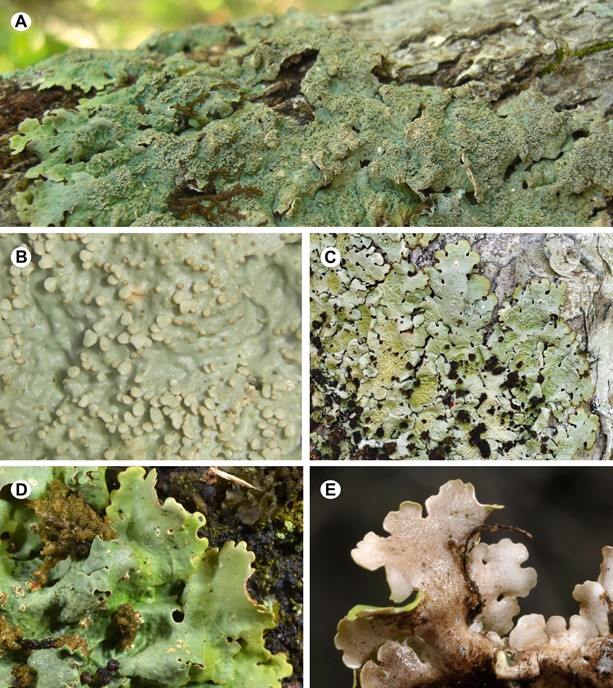Emmanuelia Ant. Simon, Lücking & Goffinet, gen. nov.
MycoBank number: MB 834643; Index Fungorum number: IF 834643; Facesoffungi number: FoF 13345;
Diagnosis: A lobarioid genus lacking cyphellae, pseudocyphellae and maculae, with a short, ± uniform lower tomentum (no veins), primarily associated with a green alga, sometimes with a den- driscocauloid cyanomorph, with gyrophoric acid (major) and 4-O-methylgyrophoric acid (congyrophoric acid; minor or absent) as secondary compounds. Morphologically and chemically similar to the genus Ricasolia, but differing in the apothecia with overarching margin and separation of the parathecium and amphithecium, consistently narrower and longer, acicular ascospores, and a subtropical to tropical distribution. Molecularly, the new genus is characterized by a short, unique rDNA sequence motif within the highly conserved 5.8S region in the ITS. The section defining Emmanuelia is as follows (deviations underlined): 5-CGAATCATCGAATCTTTGAACGCACATTGCGC- CCCYYGGYAC-3.
Generic type: Emmanuelia ravenelii (Tuck.) Ant. Simon & Goffinet
Etymology. The new taxon is named in honor of Prof. Emmanuël Sérusiaux, for his extensive contributions to advancing our understanding of the diversification of the Peltigerales.
Comments. Morphologically, Emmanuelia can be easily differentiated from Lobaria s.str. by the tomentum on the lower surface and the shape of the ascospores (Yoshimura 1998; Moncada et al. 2013). However, the newly introduced genus is quite similar to Ricasolia. In particular, like some species of Ricasolia, at least one species of Emmanuelia, E. ornata (previously often identified with the name Lobaria patinifera), produces dendriscocauloid cyanomorphs emerging from the green-algal thallus (e.g., Jordan 1972; Tønsberg et al. 2016; Fig. 6C–D). The two genera differ in their geographical distribution and ecol- ogy: Emmanuelia is a subtropical to tropical taxon found from southeastern North America to southern South America, whereas Ricasolia appears to be a strictly temperate, Northern Hemisphere taxon (Cornejo et al. 2017); the two genera are somewhat sympatric in the southeastern United States, but Emmanuelia replaces Ricasolia in coastal areas (Jordan 1973).
Morphologically, Emmanuelia differs from Ricasolia by its apothecia, rimmed by overarching and often crenulate to lobulate margins with a rough surface, whereas in Ricasolia the margins are only slightly prominent, more or less entire, and with a smooth surface, an observation also noted by Yoshimura (1998) when comparing tropical species of his ‘Lobaria quercizans group’ to Ricasolia quercizans s.str. Anatomically, in Emmanuelia the parathecium (proper excipulum) appears to be apically separated from the amphithecium (formed by the thallus cortex), by the photobiont layer reaching up to the apex, and also different in structure (prosoplectenchymatous vs. paraplectenchymatous), a characteristic referred to as ‘apothecium type II’ (Yoshimura 1971; Yoshimura & Osorio 1975). In Ricasolia the parathecium and amphithecium are apically connected, due to the photobiont layer stopping short distinctly below the apex, and at least the upper part of the parathecium is paraplectenchymatous. A further difference is found in the ascospores, with those of Emmanuelia generally acicular and arranged in a bundle and those of Ricasolia fusiform and irregularly arranged to uniseriate.
Below we provide brief diagnostic descriptions and comments for ten of the 12 species included in the new genus, and more detailed accounts for the type species, E. ravenelii, and the reinstated eastern North American E. lobulifera.

Figure 6. Habit of Emmanuelia species. A–B – E. lobulifera (Hollinger 2542), showing upper side with sparsely branched phyllidia (A) and phyllidia enlarged (B); C–E – E. ornata, showing upper side with dendriscocauloid cephalodia (C, Moncada 8401, CDS 55273), cephalodia enlarged (D, Bungartz 10972, CDS 55363), and lower side (E, Bungartz 10244, CDS 47663). Photographs A, B: courtesy of Jason Hollinger.
Species
